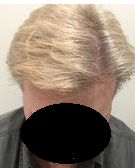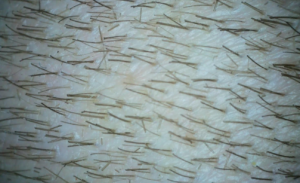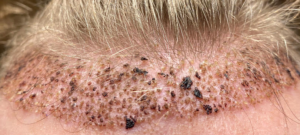The answer to that reflects the presence of the enzyme sulfotransferase in significant quantities in the scalp. “the follicular sulfotransferase activity of 120 pattern hair loss patients visiting a dermatology outpatient clinic in India. Overall, 40.8% of patients with pattern hair loss had low levels of sulfotransferase. “Reference: https://pubmed.ncbi.nlm.nih.gov/30295395/
These photos show an excellent response to the combined treatment of finasteride and microneedling. There is little doubt that the microneedling added great value here. Many men may not respond to finasteride alone; however, adding microneeding weekly, as he did, worked well with finasteride. The change is dramatic. The diffuse thinning that you see, is likely a precursor to balding, so the microneedling seemed to keck start the stem cells that control the hair growth.
One of my former patients, still on finasteride and wanting a refill, sent me this photo of his present appearance. Blonde men do better, getting the appearance of fullness. The contrast in color between skin and hair is narrow, creating more fullness with less hair. Blonde hair also reflects light, adding to the cosmetic effect. Here is a picture of one of my patients, many years after his transplant. His original balding pattern went to mid-head.
A 30-year-old man contacted me for surgery. As usual, I had him purchase a hand microscope and a micrometer. We went on Zoom, where he took control of his hand microscope. First, we used the micrometer. He measured his donor hairs (about 20 of them), and they ranged from 30 microns to 91 microns, averaging 50 microns. There was wide variation in the hair thickness of the donor area, which suggests DUPA. Then we went to the hand microscope, and he had some follicular groups with all miniaturized hairs, some with partial miniaturized hairs, and many normal groups. From what I saw, which was limited, I assumed that he had DUPA and eliminated the planned surgery for his immediate future. Of interest, he had met with 3 surgeons before contacting me; one was very well-known and respected. None of the three surgeons picked up on the DUPA diagnosis. All surgeons must examine their patients before surgery, looking for this disease, before they book the patient for a hair transplant.
THE IMPORTANT LESSON HERE IS TO MAKE SURE YOUR SURGEON DOES A MICROSCOPIC EXAMINATION OF YOUR DONOR AREA AND MEASURES YOUR HAIR THICKNESS WITH A MICROMETER. THESE TOOLS LET YOU KNOW (1) THE HEALTH OF YOUR DONOR AREA, (2) YOUR LIFETIME HAIR SUPPLY, (3) YOUR DONOR DENSITY, (4) YOUR HAIR MASS WHICH REFLECTS THE RESULTS YOU WILL GET FROM A HAIR TRANSPLANT.
This is a picture of this patient’s donor area (click to enlarge to full screen)
Hair transplants, plus minoxidil and finasteride, work wonders for him. Men like this person have a radical change in their looks, which changes their lives in many ways. First and foremost, they develop more pride in their appearance and better self-confidence. That brings changes in their social and work lives. They no longer feel ‘different’ than others.
About the 9 days, I put a bit pressure while doing the circular motion and there was no blood. Is this a safe time to have taken off the crusts?
9 days is safe, according to our article, which states: “Since crust formation only occurs in the 1-3 day post-op period, while there is still active exudate, vigorous irrigation during this period should be able to eliminate surface crusting while allowing the coagulum that formed around the graft, to hold it firmly in place. To this end, these authors are currently instructing patients to take very frequent showers, as often as every three hours the day following surgery. As anticipated, this one-day treatment seems to significantly decrease the crusting formed. Once patients pass through this “exudative” period, crusts no longer develop, and they are free to shampoo and shower as they normally do with low pressure on the shower head. Since there is no crusting, patients can theoretically resume their normal hair care activities such as shampooing, a light brushing with a large toothed brush, and styling by day 6 or, if one wants to be more cautious, at 11 days and I am still concerned about some patients whose entire recipient area is covered with a thick wall of crusts, I would add an additional 3 days before aggressively removing the crusts with good washing techniques is reasonable. I tell these patients to leave the shampoo on their scalp for 10 minutes to allow the crusts to get water-logged, then use their fingertips in a circular light motion. Keep doing this until all of the crusts are off. It might take quite a few washings.
I was scheduled to have my surgery at Eugenix but due to personal complications I had to cancel my trip and opted instead for American Mane hair transplant clinic in Miami, Florida. My surgery is at the end of the month and I am having some misgivings regarding the postulated difference between the two clinics. Eugenix has such a prolific video and photo archive of their work and are known for being one of the best clinics in the world for high Norwood cases, whereas American Mane seems virtually unknown and unregarded. I am 35 and am pretty high Norwood. I have dreamt of going to Pitella or Eugenix because of their tremendous reputation and documentation of results. Am I conceivably making a mistake having my transplant in the US at an unknown clinic with less documented evidence of results? It is seemingly a great deal at American Mane – they offer up to 5,000 grafts for $7,000. They are allegedly run by a Turkish doctor who was recruited to work in the United States. However, they have virtually no “comb through” videos that I can find.
Be very skeptical! The entire thing sounds fishy. Would you trust brain or heart surgery to a recruited doctor from Turkey doing the surgery at a discounted price? What you must remember is that a poorly done hair transplant will impact your entire life because (1) repairing these large transplant sessions is more than a simple challenge, even for a good surgeon, and (2) your donor supply used for the initial transplant is now gone. (3) will you develop a depleted donor area by getting another transplant? (4) a repair is very costly, so the money you save by the discounted price you are getting will turn into a considerable cost overrun for you if a repair is needed. and (5) it may not be repairable.
Do i put it all over my head or just the thin spots? I’m Norwood 3 so my hair is still mostly ok
Rub it in the scalp in the areas in front where you lost the hair or it is thinning. Try not to waste if on your hair, as the hair is not a living structure, just the follicle below the scalp surface. Topical minoxidil works on only 40% of men because they are missing an enzyme that converts minoxidil into its active form, minoxidil sulfate. If you take oral minoxidil on doses less than 2.5mgs/day, 100% of the minoxidil works because your liver makes the conversion for you.
This photo is 4 days after my surgery. What do you think?
Good post-operative care would have washed off all of the crusts. With the crusting shown, estimating the work you may have had to estimate the number of grafts is impossible. It would be hard to place 5500 grafts in that area. In addition, if that really happened, you have used up most of your donor supply to manage future hair loss.
I have been ridiculed, made fun of, made out to be someone I am not. This is because my hair is going and other men pick up on it and they can be cruel. Why is that?
Men who have full heads of hair and no balding in the family, rarely understand what men with hair loss go through. If your roof never leaked in a storm, why worry about it? Men with hair loss have leaky roofs. The metaphor is only mentioned because we all have to learn to live with the balding and repairs on the leaking roof are like medications for balding men. It may solve the problem short term, but in the long term, hair loss is progressive and the roof may have to be rebuilt, or a balding man may need to get a hair transplant if they want hair and want to not worry about it. My metaphor is not meant to offend anyone.
Most failed hair transplants are technically created by a team of people working on you without a good quality control process in place. That reflects the surgeon, who is Master of the Ship and responsible for what his team should be doing. I have found many surgeons who don’t understand the nuances of the hair transplant process. Grafts that are removed from the donor area can be mishandled, dried, crushed, etc.. all of this often kills the hairs. What is even more disturbing than the failed hair transplant and the lost money to pay for it is the loss of donor hair, which is not a reversible process, is the reduction of your donor area supply. You can’t buy back your donor supply. Depending upon donor density and hair quality (fine, medium or coarse hair thickness), 5500 grafts could be all this man has to transplant, so another transplant may be out of the question. He needs a real expert to assess his situation.
I am 21 years old and my hair was visibly thinning all over. I went on finasteride one year ago and all of my thinning is gone. Amazing. Is this common?
Young men (in your case 21) are often very sensitize to getting hair growth from finasteride. Total reversal at your age, is not unusual.
I have been touching and scratching my recipient area for the past month since the transplant was done. Should I worry about these red dots?
Red dots can be folliculitis which follows touching and/or scratching the recipient area. You need to see your surgeon, as folliculitis can kill the grafts
I’m four months postop and I’ll be honest I was a little embarrassed to get a haircut because of the scar but now I’m just embracing it. I’d rather have a visible star in the back of my head then no hair on top.
The scar can be concealed with SMP or just let your hair grow out a bit more. I agreed with your comment as most of my patients feel the same way as you do about getting their hair back. Strip Hair Transplants or FUE all have their cosmetic costs so there is no free ride if you want to get your hair back. For those of you who are going to make a decision to get a hair transplant, be sure to speak with your surgeon about the down sides of FUE and Strip surgery before making a decision for a hair transplant.
Page 29 of 1237









